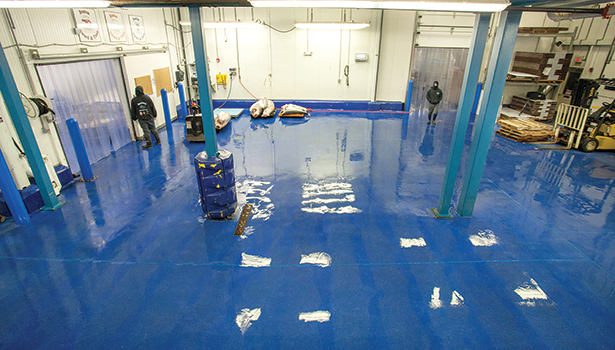Plant Flooring
Reliable and durable performance from the bottom up
Flooring must withstand an enormous amount of abuse, so whatever material is chosen, it needs to last, be safe and stay clean.










Editor's note: The sixth paragraph of this story was updated on July 24, 2020 to remove a reference to acrylic flooring having poor UV resistance.
For those involved in deciding on a plant floor, the process might resemble the children’s story of “Goldilocks and the Three Bears.” One flooring option might be too odorous, another might crack too easily, and another costs too much. Adding to the difficulty of the decision is the varying nature of food and beverage processing environments—what is appropriate for one type of application may be completely inappropriate for another.
Article Index:
- Considering the options
- Making the right choice
- Installation
- Antimicrobial choices and sanitary design
Nevertheless, the type of flooring chosen is one of the most important decisions to be made because not only will it be used every day, it is costly to install, both in terms of materials and lost productivity if a shutdown is required. Moreover, with an increased emphasis on sanitation, today’s plant floor has to withstand much harsher cleaning practices and undergo more scrutiny than in the past, adding to the importance of its reliability and durability.
Considering the options
First and foremost, food and beverage plants must protect any concrete flooring in the processing area for hygienic reasons. “Concrete is basically a sponge,” explains Sean Walsh, marketing manager of Protective Industrial Polymers in Berea, OH. “If water penetrates the concrete, it’s very dark, it’s very damp, and you can’t get cleaners down there. That’s the perfect environment for microbial growth.”
Therefore, the coating must be durable enough and thick enough to form a barrier to ensure a sanitary environment. For instance, the flooring in food and beverage processing plants may need to withstand a wide variety of substances, including the oil present in a plant that produces, for instance, snack foods or the sugar present in an industrial bakery. Flooring also must stand up to vacillating temperatures and exposure to aggressive cleaning solutions. There are three basic types of protective resin coatings to consider for concrete flooring: methyl methacrylate (MMA), epoxies and urethanes.
“Epoxies, urethanes and MMAs are all useful for [food and beverage] applications,” says Chris Smedley with High Performance Systems in Middlesex, NJ. Resinous flooring has many advantages over other offerings like vinyl composition tile (VCT) or quarry tile floors. “For one, resinous floors can accomplish a wall-to-wall, seamless surface, which eliminates hiding places for bacteria and allows the floor to be more thoroughly cleaned and sanitized. The polymers used to create resinous floors are also quite a bit stronger and more durable than the alternatives.”
One of these coating options is MMA, also referred to as acrylic flooring. “The benefit of this type of flooring is its quick turnaround to service,” says Baron Adelmann, president of Techniquex in Scottsdale, AZ. “These products dry and can be cured in as little as 30 minutes."
“They are extremely odorous,” says Keith Kwasny, president of SaniCrete in Farmington Hills, MI, “so they should be used only in well-ventilated areas. That’s the downside to the speed.”
MMA cures chemically as opposed to air drying, which also explains why it can be applied in areas that reach down to -20°F, making it a good candidate for cold rooms or freezer storage areas. However, since MMA curing is very fast, it is strongly recommended that a highly experienced contractor with a good team do the installation.
Another type of coating is epoxy, which remains a popular resin flooring option due to its lower cost and fast drying times. FDA and USDA have approved a number of epoxy flooring systems, including those with a 100 percent solids binder resin with a blended aggregate, for food and beverage processing facilities.
“Epoxies are a good choice for an aesthetically pleasing and durable floor when the temperature range is above 55°F, vapor emissions from the concrete are below three pounds, or a moisture control system is installed,” states Adelmann. However, epoxies do have some mixed results regarding their durability.
“Epoxies are multilayered systems, so they require many steps and might not cure as fast,” Kwasny says, “and they end up cracking over time.”
One flooring option growing in popularity is cement urethane, which was designed for use in food and beverage processing applications. “More and more facilities are moving toward cement urethane,” says Smedley. “Its incredible strength, resistance to temperature fluctuation and long lifespan make it hard not to use.”
Cement urethane has a thermal coefficient of expansion that is almost identical to concrete, says Adelmann. “Therefore, hot water washdowns do not affect them the way they do other floor goods.”
According to Kwasny, cement urethane floors are nonodorous and cure fast. In fact, Kwasny recommends this flooring over the others.
“In environments that do a lot of hot and cold water washdowns, people tend to go with a urethane concrete because that system has a similar rate of expansion to concrete. It expands and contracts in unison with the concrete, which makes it less susceptible to cracks,” says Walsh.
The only drawback with cement urethane floors is cost. “You’re going to pay a little more,” says Kwasny.
As for non-resin flooring, one solution is offered by Detroit, MI-based SlipNOT, which manufactures slip-resistant stainless steel flooring products, such as floor plates, grating, stair treads, drain covers, floor scale tops and ladder rungs.“SlipNOT products are installed for a wide variety of food and beverage applications, specifically where oils, fats and other liquids are prevalent,” says Grace Schroeder, marketing manager for SlipNOT.
Making the right choice
All the flooring providers, no matter their offerings, agree on one thing: You must understand your plant’s environment and needs.
“There are different types, different thicknesses and different textures [of flooring].The key is understanding the environment,” Kwasny says. “If you spend time in the beginning to pick the right floor, you’re going to minimize your headaches going forward.”
“A lot of the longevity question depends on the final use of the area and recommending the right system for it,” adds Walsh.
Smedley says High Performance Systems’ flooring engineers observe the space and its typical workflow to determine the best material for it. They consider the following five major pieces of information:
- The typical contaminants introduced to the floor (i.e., the chemicals, cleansers or oils that might touch the floor’s surface).
- Mechanical challenges imposed upon the floor (e.g., heavy forklift traffic, strong impacts from machinery, frequent thermal shock from cooking apparatuses, steam cleaning or refrigeration).
- Workplace safety issues including the need for non-slip coatings, line striping, etc.
- Budget available to complete the project.
- Timeframe allotted to produce a floor with minimal downtime for the facility.
An assessment informs flooring engineers of how thick the coating needs to be, with thicker floors having greater shock value and a longer wear cycle.
“If you select a thin floor, for instance, one-eighth or one-quarter inch, and you have an abusive environment that will damage the coating, you’ll have a spot collecting bacteria that you’ll have to patch,” says Kwasny. The repairs will cost a lot more to fix than if an appropriate match was made in the beginning.
Considering the temperatures the floor will be exposed to is equally important. “In high-temperature situations, we always use cement urethanes or MMAs, as tempting as lower-cost epoxy options may be,” explains Smedley. “Bakeries often see floor failure underneath hot lines or ovens when a low-cost epoxy has been installed.”
The next thing to consider is the appearance of the floor, whether it needs to be glossy or more matte. This can be a decorative matter, but in some instances, the choice can contribute to the durability of the floor.
“When using an epoxy, a solid color floor is recommended,” says Adelmann. “Clear epoxies do not have good UV stability. Even UV-resistant epoxy will amber and yellow over time. It just does it more slowly than standard epoxies.”
Next, a finish needs to be determined. “All the options can be produced in various textures, including non-slip and high-gloss finishes,” says Smedley. This is important since non-slip coatings are required in many processing environments to increase worker safety. Aggregates added to the coating can change the texture and hardness of the floor.
SlipNOT stainless steel flooring has a coefficient of friction, or resistance to slip accidents, greater than 0.85 compared to the US Occupational Safety and Health Administration’s recommended score of 0.50 or above for workplace environments. Schroeder says the floors “are extremely durable and long lasting, registered by NSF International, and chemical and corrosion resistant. Plus, they can withstand the extreme heat of cookers or extreme cold of cryogenics.”
All this information goes into determining the right flooring for the environment. For example, Techniquex was contacted to install a floor at the Coca-Cola bottling facility in Tempe, AZ. Since the area has high forklift traffic along with hot water washdowns, the flooring needed to be resistant to thermal shock, impacts and abrasion, as well as easy to clean. Also, Coca-Cola wanted the final product to look good. A 48-hour installation window was given, so Techniquex specified DIAMONDSTONE food process flooring RT, finished with a quartz aggregate broadcast with a clear topcoat of polyaspartic urethane.
“This floor is tough, it stands up to everything we dish out, and aesthetically, it’s beautiful,” says Coca-Cola Facilities Manager John Chubbuck.
Installation
Faster installation and drying times are becoming critical issues for food and beverage processors that want less downtime during construction or renovations. Kwasny says his company has been working on three things in the last few years to meet the needs of his clients.
“We’ve been shortening the cure times, shortening the install times—without, of course, impacting the quality—and bringing the product to cure at cooler temperatures,” he says. “In the past, 48 hours was pretty typical to install, but now it’s closer to 30 to 36 hours because the processors are not giving us more time.”
Even in the new plants, Kwasny says, flooring companies are being given less and less time since they are on the back end of construction, and if projects take longer up front, builders try to make the time up later. Additionally, installing floors at cooler temperatures has become a major sticking point in some jobs.
“A lot of processors either can’t or don’t want to change their environments. For instance, they may have a 38°F cooler,” he says. When this is the case, a competent flooring engineer can help a processor find solutions that do not need higher installation temperatures.
“A good floor contractor can minimize downtime by using quick-curing products or staging the project in multiple mobilizations, shutting down only a small section of the facility before moving on to the next,” observes Smedley. “The best-case scenario is our team coming in on an off-production night, installing everything, returning all the equipment to its normal placement and leaving no downtime for the facility.”
Proper installation is crucial to the performance and lifespan of the floor. “Most floor failures are created by bad preparation of the substrate. The only way to remedy these failures is to hire a knowledgeable contractor from the beginning,” Smedley says. “All flooring projects should begin with slab remediation—addressing control joints, expansion joints, settling of the slab, cracking, removal of old sealants, abrading the surface to achieve a good bond, etc.”
Pat Scudder, president of Protective Industrial Polymers, recommends installers do more profiling, or blasting off the top of the concrete, to make the surface rough enough for the toppings to mechanically bond to the substrate.
“The more profile you have, the better bond you have and the less risk of floor failure,” he says. Protective Industrial Polymers actually pretreats the concrete slab with a product that forms an aqueous, antimicrobial gel. “One of the biggest causes of failure is undercutting, where chemicals or water works its way underneath the coating and causes it to fail. Pretreating the concrete takes away the absorption, so the chemicals are less likely to undercut the coating.”
Antimicrobial choices and sanitary design
More stringent sanitation regulations for food and beverage processing environments, spurred by the pending Food and Safety Modernization Act (FSMA), are drawing new attention to the cleanability of flooring.
“The FSMA includes the most sweeping food safety laws in the past 70 years,” says Rebecca Dolton, regional market segment director of food and beverage for Sherwin-Williams Protective & Marine Coatings. “Facilities are under tough scrutiny by third-party auditors to maintain a clean, safe working environment.”
USDA and FDA guidelines state that food contamination risks can be reduced by installing a flooring product with the best food safety standards built into its design. To ensure a sanitary floor, the regulations recommend processing plants use materials that are impervious to water and can withstand the use of more aggressive cleaning chemicals and routines.
“Stainless steel products will not contaminate the end product and are resilient to cleaning agents,” says SlipNOT’s Schroeder. However, resinous floors are often promoted as a more hygienic solution because they are seamless, thus making them easier to clean and reducing the number of areas where bacteria could thrive.
“Antimicrobial additives can also be dispersed in the resins, providing further protection from bacteria, if the topcoat should be scratched,” says Smedley.
Flowcrete Americas combines natural silver ion-based antimicrobial into the matrix of its resin flooring material. “In an exclusive global partnership with Polygiene, Flowcrete has designed a cementitious urethane flooring system to reduce the bacterial population on the surface of the floor by up to 99.9 percent,” says Itzel Hernandez, marketing associate for Flowcrete.
However, there has been some debate surrounding the effectiveness of these antimicrobial flooring options. “Antimicrobial additives are not new; they’ve been around for a while,” says Walsh of Protective Industrial Polymers. “Many companies utilize them, and in the past, we were one of them.” He explains that if a crew mixes the coating material in the field with an antimicrobial additive before applying it, they can call the flooring antimicrobial.
“What we found out is that it could be or it couldn’t be [antimicrobial],” he says. By working with an independent test lab, Protective Industrial Polymers discovered additives react differently when mixed with various materials. According to Walsh, “A certain percentage of an antimicrobial additive in an epoxy might work, but if you mix it into urethane, it may not react in the same way,” which might make it less effective. The company decided the antimicrobial product needed to be manufactured at its plant rather than mixed in the field.
“We pretreat the concrete [in InhibiCrobe floor and wall systems] before putting any antimicrobial top coating on it,” Walsh says. A colloidal product is sprayed onto the concrete, penetrating six inches deep, filling all of the voids and forming an aqueous gel to densify the substrate with antimicrobial properties.
“The whole idea is redundant antimicrobial protection, which fits in very well with FSMA,” he continues. “That’s our whole kind of world—creating a building envelope protection, where you can coat the walls and the floors and integrally connect them, so it’s a very sanitary environment without breaks or voids.”
However, questions surrounding a flooring’s durability and length of service always remain, and inevitably, the coating will wear out or fail in some way. “No matter how the polymers are put in, they are, by definition, a temporary solution,” says Protective Industrial Polymers’ Scudder. “The only permanent function is the substrate itself, so it seems crazy not to make that antimicrobial because then you have permanently improved antimicrobial protection.”
When a plant does experience that eventual floor failure, Scudder says the pretreatment of the concrete will still provide antimicrobial support and help with repairing the coating. “That pretreatment helps keep the concrete from absorbing chemicals and contamination, so it’s as simple as re-profiling the concrete and reapplying the coating. You don’t have to extract any contamination or try to sterilize the concrete.”
The structural design of the flooring, specifically the physical orientation of it and how it drains, also has become crucial to the sanitation of a plant.
“The ideal situation eliminates all standing water and debris from the floor as quickly as possible,” offers Smedley. “To this end, trench drain placement, sloping the slab toward drainage and top coating [the floor] with an impervious and seamless system are paramount.”
“As for sloping the drains, that’s absolutely crucial in a retrofit,” Kwasny says. “We can take a flat floor and slope it to that drain. At a minimum, one-eighth of an inch per foot fall is important to get positive drainage because puddling water is a no-no in the food industry.”
New regulations dictate plant flooring should be easy to clean, even in corners where the floor meets the wall, which, because of their inaccessibility, are identified as places of potential bacterial growth. To remedy this situation, FDA suggests “there must be coving at base junctures that is compatible with both wall and floor coverings. The coving should provide at least a one-quarter-inch radius and four-inch height.” Most flooring companies now offer this type of cove base application, such as Sherwin-Williams’ FasTop urethane concrete flooring system.
“It ties directly into the wall system, providing a seamless transition from floor to wall,” says Dolton. “This eliminates the opportunity for bacteria to collect in the area where the floor meets the wall and allows for better cleaning. When a cove base is installed with a proper slope to drain, ponding water is reduced.” And this can help prevent the flooring from becoming an issue in the facility’s next audit.
Looking for a reprint of this article?
From high-res PDFs to custom plaques, order your copy today!













